Imprinting its footprints in varied zones in the healthcare space, AI is all set to enable feasible transitions in the radiology sector.
FREMONT, CA: The radiology sector has undergone a paradigm shift in recent years, following seamless technology-driven innovations in the arena. That is, the work quality of radiologists, the facilitation of clear images, and the interaction with machines are likely to accelerate the pace and accuracy of the results for a brighter future. As an integral constituent of the medical field, the medical imaging space is all set to evolve via Artificial Intelligence (AI)-induced transitions in the healthcare space. However, with the demand for induced and acute images and the ability to manage its analytics considerably on the rise, physicians in the domain are likely seeking out plausible opportunities for an efficient diagnosis.
Using AI in radiology allows for increased decision-making efficiency, thereby accelerating patient outcomes. Alongside this, accelerated population growth and diminishing human resources in the area are likely instigating the need for technology within the overall processing of radiology, yet with a reduced source of resources. As a result, AI has carved out its space in radiology, accelerating the healthcare appeal dimension substantially.
Though deployed in varied sectors over decades, AI accounts for an induced significance in the radiology department, specifically indicating an intensified future in the discipline.

